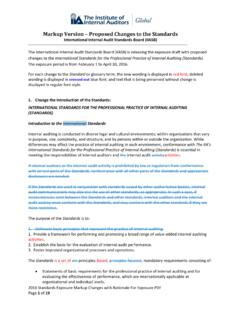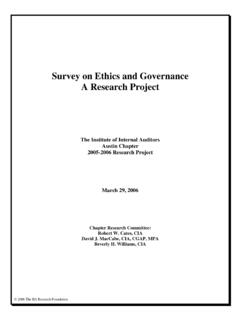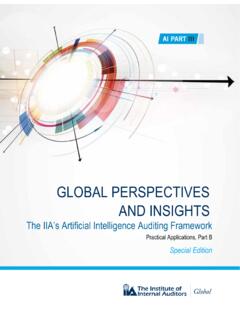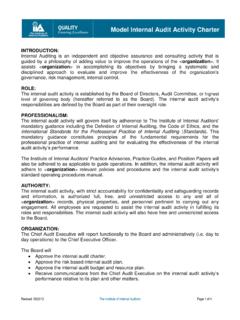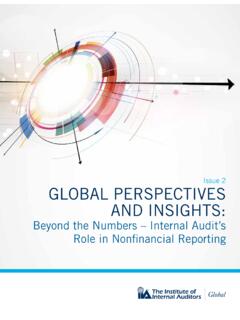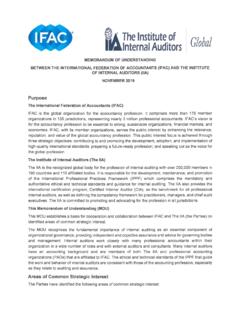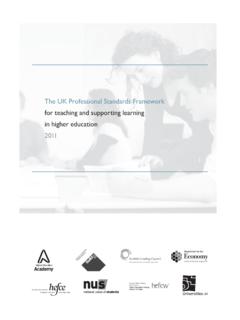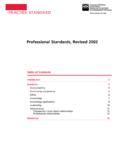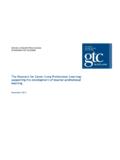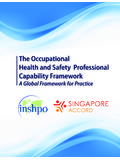Transcription of INTERNATIONAL STANDARDS FOR THE …
1 Revised: October 2016 Page 1 of 28 Effective: January 2017 2016 The Institute of internal Auditors INTERNATIONAL STANDARDS FOR THE professional PRACTICE OF internal auditing ( STANDARDS ) Introduction to the INTERNATIONAL STANDARDS internal auditing is conducted in diverse legal and cultural environments; withinfor organizations that vary in purpose, size, complexity, and structure; and by persons within or outside the organization. While differences may affect the practice of internal auditing in each environment, conformance with The IIA s INTERNATIONAL STANDARDS for the professional Practice of internal auditing ( STANDARDS ) is essential in meeting the responsibilities of internal auditors and the internal audit activity. If internal auditors or the internal audit activity is prohibited by law or regulation from conformance with certain parts of the STANDARDS , conformance with all other parts of the STANDARDS and appropriate disclosures are the STANDARDS are used in conjunction with STANDARDS issued by other authoritative bodies, internal audit communications may also cite the use of other STANDARDS , as appropriate.
2 In such a case, if inconsistencies exist between the STANDARDS and other STANDARDS , internal auditors and the internal audit activity must conform with the STANDARDS , and may conform with the other STANDARDS if they are more restrictive. The purpose of the STANDARDS is to: 1. Delineate basic principles that represent the practice of internal auditing . 1. Guide adherence with the mandatory elements of the INTERNATIONAL professional practices Framework. 2. Provide a framework for performing and promoting a broad range of value-added internal auditing . services. 3. Establish the basis for the evaluation of internal audit performance. 4. Foster improved organizational processes and operations. The STANDARDS are a set of principles-focusedbased, mandatory requirements consisting of: Statements of basiccore requirements for the professional practice of internal auditing and for evaluating the effectiveness of performance, which that are internationally applicable at organizational and individual levels.
3 Interpretations, which clarify clarifying terms or concepts within the Statements. STANDARDS . The STANDARDS , together with the Code of Ethics, encompass all mandatory elements of the INTERNATIONAL professional practices Framework; therefore, conformance with the Code of Ethics and the STANDARDS demonstrates conformance with all mandatory elements of the INTERNATIONAL professional practices Framework. The STANDARDS employ terms that have been givenas defined specifically in the Glossary. To understand and apply the STANDARDS correctly, it is necessary to consider the specific meanings that are included infrom the Glossary. SpecificallyFurthermore, the STANDARDS use the word must to specify an unconditional requirement and the word should where conformance is expected unless, when applying professional judgment, circumstances justify deviation. INTERNATIONAL STANDARDS for the professional Practice of internal auditing ( STANDARDS ) Revised: October 2016 Page 2 of 28 Effective: January 2017 2016 The Institute of internal Auditors It is necessary to consider the Statements and their Interpretations as well as the specific meanings from the Glossary to understand and apply the STANDARDS correctly.
4 The structure of the STANDARDS is divided betweenThe STANDARDS comprise two main categories: Attribute and Performance STANDARDS . Attribute STANDARDS address the attributes of organizations and individuals performing internal auditing . The Performance STANDARDS describe the nature of internal auditing and provide quality criteria against which the performance of these services can be measured. The Attribute and Performance STANDARDS are also provided to apply to all internal audit services. Implementation STANDARDS are also provided to expand upon the Attribute and Performance STANDARDS , STANDARDS by providing the requirements applicable to assurance ((.A) or consulting ((.C) activities. services. Assurance services involve the internal auditor s objective assessment of evidence to provide an independent opinionopinions or conclusions regarding an entity, operation, function, process, system, or other subject mattermatters.))
5 The nature and scope of thean assurance engagement are determined by the internal auditor. There are generallyGenerally, three parties involvedare participants in assurance services: (1) the person or group directly involved with the entity, operation, function, process, system, or other subject matter the process owner, (2) the person or group making the assessment the internal auditor, and (3) the person or group using the assessment the user. Consulting services are advisory in nature, and are generally performed at the specific request of an engagement client. The nature and scope of the consulting engagement are subject to agreement with the engagement client. Consulting services generally involve two parties: (1) the person or group offering the advice the internal auditor, and (2) the person or group seeking and receiving the advice the engagement client.
6 When performing consulting services the internal auditor should maintain objectivity and not assume management responsibility. The STANDARDS apply to individual internal auditors and the internal audit activitiesactivity. All internal auditors are accountable for conforming with the sStandards related to individual objectivity, proficiency, and due professional care. In addition, internal auditors are accountable for conforming with , and the sStandards, which are relevant to the performance of their job responsibilities. Chief audit executives are additionally accountable for the internal audit activity s overall conformance with the STANDARDS . If internal auditors or the internal audit activity is prohibited by law or regulation from conformance with certain parts of the STANDARDS , conformance with all other parts of the STANDARDS and appropriate disclosures are needed.
7 If the STANDARDS are used in conjunction with requirements issued by other authoritative bodies, internal audit communications may also cite the use of other requirements, as appropriate. In such a case, if the internal audit activity indicates conformance with the STANDARDS and inconsistencies exist between the STANDARDS and other requirements, internal auditors and the internal audit activity must conform with the STANDARDS and may conform with the other requirements if such requirements are more restrictive. The review and development of the STANDARDS is an ongoing process. The INTERNATIONAL internal Audit STANDARDS Board engages in extensive consultation and discussion prior tobefore issuing the STANDARDS . This includes worldwide solicitation for public comment through the exposure INTERNATIONAL STANDARDS for the professional Practice of internal auditing ( STANDARDS ) Revised: October 2016 Page 3 of 28 Effective: January 2017 2016 The Institute of internal Auditors draft process.
8 All exposure drafts are posted on The IIA s Web sitewebsite as well as being distributed to all IIA institutes. Suggestions and comments regarding the STANDARDS can be sent to: The Institute of internal Auditors STANDARDS and Guidance 1035 Greenwood Blvd, Suite 401 Lake Mary, FL 32746 USA E-mail: Web: ** INTERNATIONAL STANDARDS for the professional Practice of internal auditing ( STANDARDS ) Revised: October 2016 Page 4 of 28 Effective: January 2017 2016 The Institute of internal Auditors INTERNATIONAL STANDARDS FOR THE professional PRACTICE OF internal auditing ( STANDARDS ) Attribute STANDARDS 1000 Purpose, Authority, and Responsibility The purpose, authority, and responsibility of the internal audit activity must be formally defined in an internal audit charter, consistent with the Definition of internal auditing , the Code of Ethics, and the of internal Audit and the mandatory elements of the INTERNATIONAL professional practices Framework (the Core Principles for the professional Practice of internal auditing , the Code of Ethics, the STANDARDS , and the Definition of internal auditing ).
9 The chief audit executive must periodically review the internal audit charter and present it to senior management and the board for approval. Interpretation: The internal audit charter is a formal document that defines the internal audit activity's purpose, authority, and responsibility. The internal audit charter establishes the internal audit activity's position within the organization, including the nature of the chief audit executive s functional reporting relationship with the board; authorizes access to records, personnel, and physical properties relevant to the performance of engagements; and defines the scope of internal audit activities. Final approval of the internal audit charter resides with the board. The nature of assurance services provided to the organization must be defined in the internal audit charter.
10 If assurances are to be provided to parties outside the organization, the nature of these assurances must also be defined in the internal audit charter. The nature of consulting services must be defined in the internal audit charter. 1010 Recognition of the Definition of internal auditing , the Code of Ethics, and the StandardsRecognizing Mandatory Guidance in the internal Audit Charter The mandatory nature of the Core Principles for the professional Practice of internal auditing , the Code of Ethics, the STANDARDS , and the Definition of internal auditing , the Code of Ethics, and the STANDARDS must be recognized in the internal audit charter. The chief audit executive should discuss the DefinitionMission of internal auditing , Audit and the mandatory elements of the Code of Ethics, and the StandardsInternational professional practices Framework with senior management and the board.

